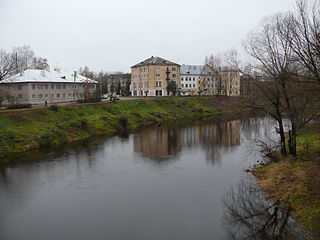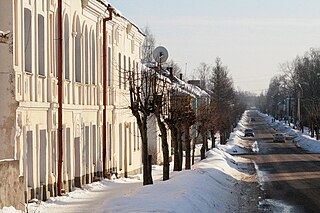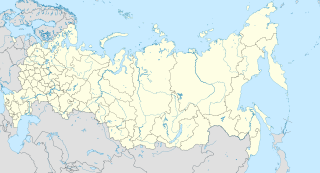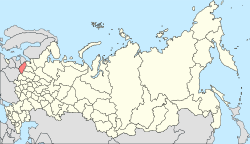
Porkhov is a town and the administrative center of Porkhovsky District in Pskov Oblast, Russia, located on the Shelon River, 75 kilometers (47 mi) east of Pskov, the administrative center of the oblast. Population: 10,608 (2010 Census); 12,263 (2002 Census); 14,170 (1989 Census).

Opochka is a town and the administrative center of Opochetsky District in Pskov Oblast, Russia, located on the Velikaya River, 130 kilometers (81 mi) south of Pskov, the administrative center of the oblast. Population: 11,603 (2010 Census); 13,964 (2002 Census); 16,190 (1989 Census).

Dno is a town and the administrative center of Dnovsky District in Pskov Oblast, Russia, located at the intersection of the Pskov–Bologoye and St. Petersburg–Kiev railways, 113 kilometers (70 mi) east of Pskov, the administrative center of the oblast. Population: 9,061 (2010 Census); 10,049 (2002 Census); 12,406 (1989 Census).

Sebezh is a town and the administrative center of Sebezhsky District in Pskov Oblast, Russia, located in a picturesque setting between Lakes Sebezhskoye and Orono 189 kilometers (117 mi) south of Pskov, the administrative center of the oblast. Population: 6,375 (2010 Census); 7,138 (2002 Census); 9,497 (1989 Census).

Novorzhev is a town and the administrative center of Novorzhevsky District in Pskov Oblast, Russia, located on the Sorot River 144 kilometers (89 mi) southeast of Pskov, the administrative center of the oblast. Population: 3,695 (2010 Census); 4,125 (2002 Census); 5,050 (1989 Census).

Novosokolniki is a town and the administrative center of Novosokolnichesky District in Pskov Oblast, Russia, located on the Maly Udray River at the junction of the St. Petersburg–Kiev and Moscow–Riga railways, 287 kilometers (178 mi) southeast of Pskov, the administrative center of the oblast. Population: 8,119 (2010 Census); 9,757 (2002 Census); 10,689 (1989 Census).

Pustoshka is a town and the administrative center of Pustoshkinsky District in Pskov Oblast, Russia, located on the Krupeya River, 191 kilometers (119 mi) southeast of Pskov, the administrative center of the oblast. Population: 4,619 (2010 Census); 5,509 (2002 Census); 6,332 (1989 Census).

Bezhanitsy is an urban locality and the administrative center of Bezhanitsky District of Pskov Oblast, Russia. It is one of the two urban-type settlements in the district. Population: 4,333 (2010 Census); 4,846 (2002 Census); 6,789 (1989 Census).

Plyussa is an urban locality and the administrative center of Plyussky District of Pskov Oblast, Russia, located 91 kilometers (57 mi) northeast of Pskov by the Plyussa River. Municipally, it is incorporated as Plyussa Urban Settlement, one of the two urban settlements in the district. Population: 3,450 (2010 Census); 3,856 (2002 Census); 4,317 (1989 Census).

Krasnogorodsky District is an administrative and municipal district (raion), one of the twenty-four in Pskov Oblast, Russia. It is located in the west of the oblast and borders with Ostrovsky District in the north, Pushkinogorsky District in the northeast, Opochetsky District in the southeast, Sebezhsky District in the south, Cibla and Kārsava municipalities of Latvia in the southwest, and with Pytalovsky District in the west. The area of the district is 1,320.42 square kilometers (509.82 sq mi). Its administrative center is the urban locality of Krasnogorodsk. Population: 7,328 (2010 Census); 9,800 ; 11,886 (1989 Census). The population of Krasnogorodsk accounts for 52.8% of the district's total population.

Palkinsky District is an administrative and municipal district (raion), one of the twenty-four in Pskov Oblast, Russia. It is located in the west of the oblast and borders with Pskovsky District in the northwest, Ostrovsky District in the southeast, Pytalovsky District in the south, Viļaka and Alūksne Municipalities of Latvia in the southwest, and with Pechorsky District in the northwest. The area of the district is 1,191.2 square kilometers (459.9 sq mi). Its administrative center is the urban locality of Palkino. Population: 8,826 (2010 Census); 10,520 ; 12,392 (1989 Census). The population of Palkino accounts for 33.1% of the district's total population.

Pechorsky District is an administrative and municipal district (raion), one of the twenty-four in Pskov Oblast, Russia. It is located in the northwest of the oblast and borders with Pskovsky District in the northwest, Palkinsky District in the southeast, Alūksne municipality of Latvia in the southwest, and with Võru and Põlva Counties of Estonia in the northwest. Lake Peipus limits the district from the north. The area of the district is 1,251 square kilometers (483 sq mi). Its administrative center is the town of Pechory. Population: 22,123 (2010 Census); 25,300 ; 27,199 (1989 Census). The population of Pechory accounts for 50.6% of the district's total population.

Pskovsky District is an administrative and municipal district (raion), one of the twenty-four in Pskov Oblast, Russia. It is located in the northwest of the oblast and borders with Gdovsky District in the north, Strugo-Krasnensky District in the northeast, Porkhovsky District in the east, Ostrovsky District in the south, and with Palkinsky and Pechorsky Districts in the southwest. Lake Peipus forms the border with Estonia in the west. The area of the district is 3,600 square kilometers (1,400 sq mi). Its administrative center is the city of Pskov. Population: 34,323 (2010 Census); 37,216 ; 37,557 (1989 Census).

Pytalovsky District is an administrative and municipal district (raion), one of the twenty-four in Pskov Oblast, Russia. It is located in the west of the oblast and borders with Palkinsky District in the north, Ostrovsky District in the east, Krasnogorodsky District in the south, and with Kārsava, Baltinava, and Viļaka municipalities of Latvia in the west. The area of the district is 1,111 square kilometers (429 sq mi). Its administrative center is the town of Pytalovo. Population: 12,083 (2010 Census); 14,853 ; 16,167 (1989 Census). The population of Pytalovo accounts for 48.2% of the district's total population.
Sebezhsky District is an administrative and municipal district (raion), one of the twenty-four in Pskov Oblast, Russia. It is located in the southwest of the oblast and borders with Rasony and Verkhnyadzvinsk Districts of Vitebsk Oblast of Belarus in the south, Zilupe, Ludza, and Cibla municipalities of Latvia in the west, Krasnogorodsky and Opochetsky Districts in the north, and with Pustoshkinsky and Nevelsky Districts in the east. The area of the district is 3,100 square kilometers (1,200 sq mi). Its administrative center is the town of Sebezh. Population: 21,674 (2010 Census); 25,473 ; 26,926 (1989 Census). The population of Sebezh accounts for 29.4% of the district's total population.

Zaplyusye is an urban locality in Plyussky District of Pskov Oblast, Russia, located in the east of the district, right at the border with Leningrad Oblast. Municipally, it is incorporated as Zaplyusye Urban Settlement in Plyussky Municipal District, one of the two urban settlements in the district. Population: 1,096 (2010 Census); 1,393 (2002 Census); 1,887 (1989 Census).

Krasnogorodsk is an urban locality and the administrative center of Krasnogorodsky District of Pskov Oblast, Russia, located on the Sinyaya River south of Pskov. Municipally, it is incorporated as Krasnogorodsk Urban Settlement, the only urban settlement in the district. Population: 3,870 (2010 Census); 4,694 (2002 Census); 5,295 (1989 Census).

Pushkinskiye Gory is an urban locality and the administrative center of Pushkinogorsky District of Pskov Oblast, Russia. Municipally, it is incorporated as Pushkinogorye Urban Settlement, the only urban settlement in the district. Population: 5,222 (2010 Census); 6,089 (2002 Census); 7,067 (1989 Census).

Idritsa is an urban locality in Sebezhsky District of Pskov Oblast, Russia, located on the Idritsa River, a left tributary of the Velikaya River. Municipally, it is incorporated as Idritsa Urban Settlement, one of the three urban settlements in the district. Population: 4,988 (2010 Census); 5,784 (2002 Census); 5,485 (1989 Census).

Kunya is an urban locality and the administrative center of Kunyinsky District of Pskov Oblast, Russia. Municipally, it is incorporated as Kunya Urban Settlement, the only urban settlement in the district. Population: 3,127 (2010 Census); 3,527 (2002 Census); 4,023 (1989 Census).

















